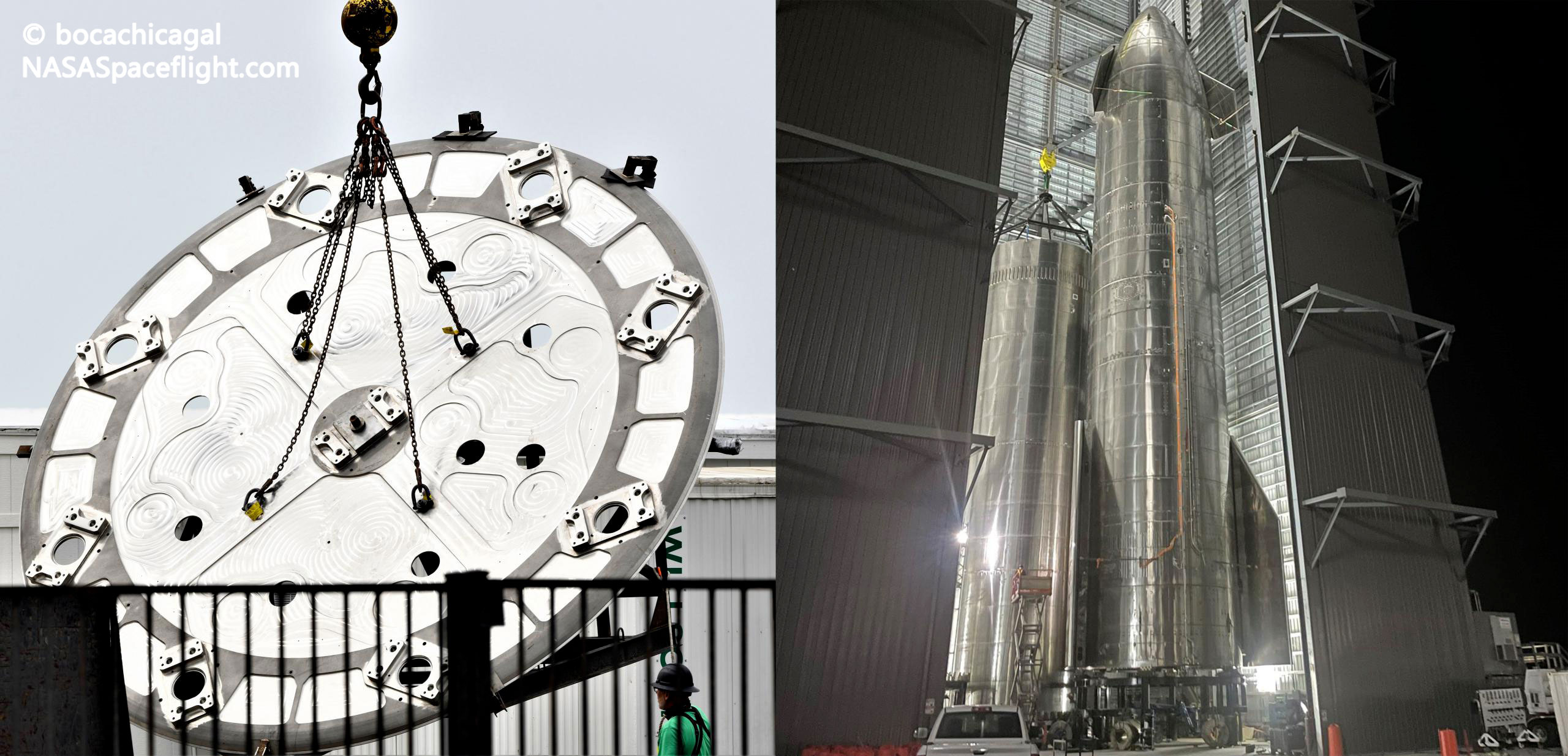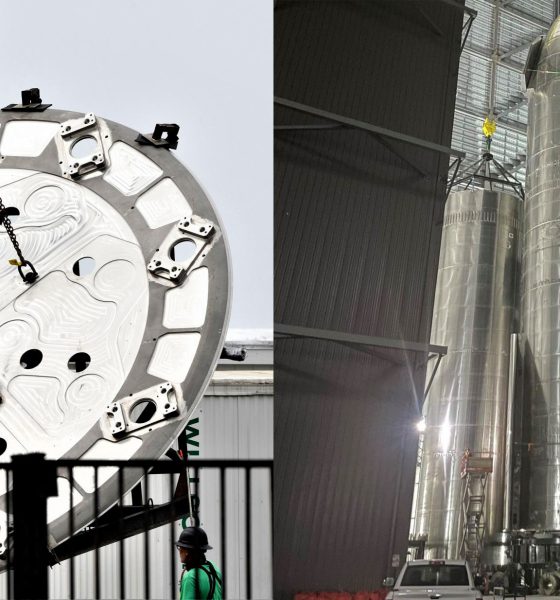

News
SpaceX bumps Starship booster engine count, ramps up Raptor factory
SpaceX CEO Elon Musk has confirmed that Starship’s Super Heavy booster will have at least one more engine than expected after hardware spotted at its Boca Chica, Texas factory indicated as much.
Simultaneously, Musk revealed that SpaceX’s Hawthorne, California factory and headquarters is now producing Raptors at a rate that will likely make it the company’s most numerous product (outside of Starlink) in the near future.
Musk says that Super Heavy boosters will “initially” have 29 Raptor engines instead of 28 engines and could even be upgraded to 32 engines down the road. In 2020, the vehicle’s design was updated, dropping from 31 to 28 engines for unknown reasons before SpaceX began work on the first real Super Heavy hardware. Known as BN1 or booster number 1, that rocket was stacked to its full ~70m (~230 ft) height but ultimately turned into a manufacturing pathfinder (i.e. practice) after Super Heavy’s design changed once again.
Who or what has been causing those seemingly endless design changes is unclear but SpaceX is finally at a point where any more major changes will explicitly delay plans for Starship’s inaugural spaceflight – deemed an “orbital test flight” by the company. It remains to be seen if SpaceX will actually attempt to recover the first booster(s) after those initial quasi-orbital test flights but we now have a better idea of what those Super Heavies might look like.
Namely, Musk seems to indicate that even the very first flightworthy prototypes will be outfitted with a full complement of Raptors – seemingly nipping in the bud the possibility of a booster debuting with the fewest possible engines. In the case of the first few initial orbital launch, that means that SpaceX is happy to risk losing 32-35 engines for every single attempt.
That could imply several things. SpaceX might be extremely confident that early boosters will be recovered. It could have zero faith in the reusability of early flown Raptors, meaning that they’re functionally expendable regardless of the outcome. SpaceX could have also reduced the cost and increased the speed of production to the point that expending dozens of Raptors isn’t a major issue – though ~32 Raptors would cost $8 million even if SpaceX has already hit Musk’s long-term “<$250k” per-engine target.
However, Musk also says that SpaceX has ramped up Raptor production to the point that it’s almost completing one engine every 48 hours – equating to around 180 Raptors per year or a maximum cadence of one expendable three-engine Starship and 29-engine booster launch every nine weeks. At that run rate, Raptor has likely beat out Falcon’s venerable Merlin to become SpaceX’s most-produced rocket engine.
According to NASASpaceflight, SpaceX has already begun work on Raptors with serial numbers in the 150s. Two new Raptor test stands in work at its McGregor development facilities will also reportedly enable an average of one engine qualification every day – enough testing capacity to outfit 6 boosters and 30 Starships (~365 Raptors) per year. In short, SpaceX is well on its way to having the ability to manufacture and power a truly vast fleet of Starships and Super Heavy boosters.

Elon Musk
Judge clears path for Elon Musk’s OpenAI lawsuit to go before a jury
The decision maintains Musk’s claims that OpenAI’s shift toward a for-profit structure violated early assurances made to him as a co-founder.

A U.S. judge has ruled that Elon Musk’s lawsuit accusing OpenAI of abandoning its founding nonprofit mission can proceed to a jury trial.
The decision maintains Musk’s claims that OpenAI’s shift toward a for-profit structure violated early assurances made to him as a co-founder. These claims are directly opposed by OpenAI.
Judge says disputed facts warrant a trial
At a hearing in Oakland, U.S. District Judge Yvonne Gonzalez Rogers stated that there was “plenty of evidence” suggesting that OpenAI leaders had promised that the organization’s original nonprofit structure would be maintained. She ruled that those disputed facts should be evaluated by a jury at a trial in March rather than decided by the court at this stage, as noted in a Reuters report.
Musk helped co-found OpenAI in 2015 but left the organization in 2018. In his lawsuit, he argued that he contributed roughly $38 million, or about 60% of OpenAI’s early funding, based on assurances that the company would remain a nonprofit dedicated to the public benefit. He is seeking unspecified monetary damages tied to what he describes as “ill-gotten gains.”
OpenAI, however, has repeatedly rejected Musk’s allegations. The company has stated that Musk’s claims were baseless and part of a pattern of harassment.
Rivalries and Microsoft ties
The case unfolds against the backdrop of intensifying competition in generative artificial intelligence. Musk now runs xAI, whose Grok chatbot competes directly with OpenAI’s flagship ChatGPT. OpenAI has argued that Musk is a frustrated commercial rival who is simply attempting to slow down a market leader.
The lawsuit also names Microsoft as a defendant, citing its multibillion-dollar partnerships with OpenAI. Microsoft has urged the court to dismiss the claims against it, arguing there is no evidence it aided or abetted any alleged misconduct. Lawyers for OpenAI have also pushed for the case to be thrown out, claiming that Musk failed to show sufficient factual basis for claims such as fraud and breach of contract.
Judge Gonzalez Rogers, however, declined to end the case at this stage, noting that a jury would also need to consider whether Musk filed the lawsuit within the applicable statute of limitations. Still, the dispute between Elon Musk and OpenAI is now headed for a high-profile jury trial in the coming months.
News
Tesla Giga Shanghai celebrates 5 million electric drive unit milestone
The milestone was celebrated by the company in a post on its official Weibo account.

Tesla China has reached another manufacturing milestone at Gigafactory Shanghai, rolling out the facility’s 5 millionth locally produced drive unit.
The milestone was celebrated by the company in a post on its official Weibo account. In its post, the Giga Shanghai team could be seen posing with the 5 millionth drive unit.
Giga Shanghai’s major benchmark
The milestone drive unit was produced at Gigafactory Shanghai, which produces the Model Y and the Model 3. In a release, Tesla China noted that its three-in-one integrated electric drive system combines the motor, gearbox, and inverter into a single compact assembly. This forms a powerful “heart” for the company’s electric cars.
Tesla China also noted that its drive units’ integrated design improves energy conversion efficiency while reducing overall weight and complexity, benefits that translate into stronger performance, improved handling, and longer service life for its vehicles.

The new milestone builds on earlier achievements at the same site. In July 2024, Tesla announced that its 10 millionth electric drive system globally had rolled off the line at the Shanghai plant, making it the first self-produced Tesla component to reach that volume.
More recently, the factory also produced its 4 millionth China-made vehicle, a Model Y L. The factory has also continued hitting global production milestones, rolling out Tesla’s 9 millionth EV worldwide late last year, with the landmark vehicle being a Tesla Model Y.
Tesla China’s role
Construction of Giga Shanghai began in January 2019, with production starting by the end of that year. This made it the first wholly foreign-owned automotive manufacturing project in China. The facility began delivering Model 3 vehicles locally in early 2020 and added Model Y production in 2021. The plant is now capable of producing about 1 million vehicles annually.

Throughout 2025, Giga Shanghai delivered 851,732 vehicles, representing a 7.08% year-on-year decline, according to data compiled by CNEVPost. Even so, recent months showed renewed momentum.
In December alone, Tesla China recorded wholesale sales of 97,171 vehicles, including domestic deliveries and exports, making it the company’s second-best monthly total on record, per data from the China Passenger Car Association. Retail sales during December reached roughly 94,000 units, up about 13% year over year.
Investor's Corner
Tesla price target boost from its biggest bear is 95% below its current level

Tesla stock (NASDAQ: TSLA) just got a price target boost from its biggest bear, Gordon Johnson of GLJ Research, who raised his expected trading level to one that is 95 percent lower than its current trading level.
Johnson pushed his Tesla price target from $19.05 to $25.28 on Wednesday, while maintaining the ‘Sell’ rating that has been present on the stock for a long time. GLJ has largely been recognized as the biggest skeptic of Elon Musk’s company, being particularly critical of the automotive side of things.
Tesla has routinely been called out by Johnson for negative delivery growth, what he calls “weakening demand,” and price cuts that have occurred in past years, all pointing to them as desperate measures to sell its cars.
Johnson has also said that Tesla is extremely overvalued and is too reliant on regulatory credits for profitability. Other analysts on the bullish side recognize Tesla as a company that is bigger than just its automotive side.
Many believe it is a leader in autonomous driving, like Dan Ives of Wedbush, who believes Tesla will have a widely successful 2026, especially if it can come through on its targets and schedules for Robotaxi and Cybercab.
Justifying the price target this week, Johnson said that the revised valuation is based on “reality rather than narrative.” Tesla has been noted by other analysts and financial experts as a stock that trades on narrative, something Johnson obviously disagrees with.
Dan Nathan, a notorious skeptic of the stock, turned bullish late last year, recognizing the company’s shares trade on “technicals and sentiment.” He said, “From a trading perspective, it looks very interesting.”
Tesla bear turns bullish for two reasons as stock continues boost
Johnson has remained very consistent with this sentiment regarding Tesla and his beliefs regarding its true valuation, and has never shied away from putting his true thoughts out there.
Tesla shares closed at $431.40 today, about 95 percent above where Johnson’s new price target lies.








